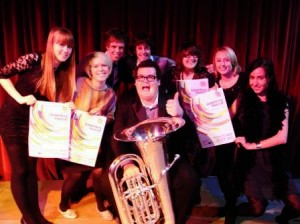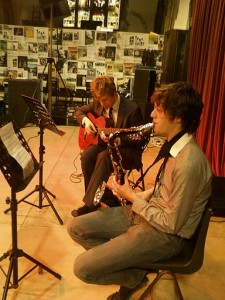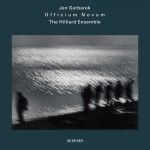I’ve done three Scholars’ Festival Lunchtime Concerts in the Canterbury Festival since my time at Kent began, and I’ve never seen the Festival Club as packed as it was on Friday. The audience were crammed into every available space, with extra seating having to be put out along the sides, and the view from the stage was rather intimidating.

Not intimidating enough, however, to dismay the array of Music Scholars, who performed a diverse and entertaining programme that clearly delighted a packed house.
Politics student and flautist with the University Orchestra, Alice Godwin, opened the concert with a pair of charming pieces by Benjamin Godard, and was followed by Anna Beth Saffery, reading Drama, who sang Mozart’s breathless Voi che sapete and gave a lulling rendition of A Nightingale Sang in Berkeley Square.
Architecture student Chris Gray performed the first movement of Gregson’s Tuba Concerto, and demonstrated that, whilst it may be the largest of the instruments in the orchestra, it can also be one of the most light-footed – he gave a deft performance, full of agility and lyricism.
Clarinet tutor and Big Band conductor Ian Swatman led a clarinet trio in an arrangement of music by Bach, with Kate Lumley (English Language) and Sarah Davies (English Literature), who are stalwarts of both the University Orchestra’s clarinet section and the Concert Band.

The mood then shifted to jazz, as guitarist Andrew Kitchin (Maths) and saxophonist Will Rathbone (Drama) played two standards, The Nearness of You and Blue Bossa, with Ian Swatman sitting in. Both Will and Andrew have been bastions of the ‘Jazz @ 5’ series in the Gulbenkian each month, and here showed the same relaxed attitude to playing that has made them so indispensable to the series.
 Bringing the concert to a sparkling conclusion (and not simply because of her shoes) was soprano Lena Younes (History and Drama), who sang Lullaby of Birdland before giving a crowd-pleasing and characterful performance of Flanders and Swann’s The Warthog.
Bringing the concert to a sparkling conclusion (and not simply because of her shoes) was soprano Lena Younes (History and Drama), who sang Lullaby of Birdland before giving a crowd-pleasing and characterful performance of Flanders and Swann’s The Warthog.
Accompanied throughout by Deputy Director of Music, Dan Harding, the concert proved once again that the University’s music department is rich in young, talented musicians, even though there is no formal music degree on the Canterbury campus. Congratulations to everyone who performed.
 Thank you to Ian Swatman, and to Sarah Passfield who hosted the event and assisted us in setting up, and who made us feel very welcome.
Thank you to Ian Swatman, and to Sarah Passfield who hosted the event and assisted us in setting up, and who made us feel very welcome.


 Pursuing the line of thought
Pursuing the line of thought  Kasai Masai are a 5-piece band based in London and led by Nickens Nkoso. Named after a region in Congo, their sound is a very authentic African one, full of infectious rhythms and driving guitar hooks.
Kasai Masai are a 5-piece band based in London and led by Nickens Nkoso. Named after a region in Congo, their sound is a very authentic African one, full of infectious rhythms and driving guitar hooks.

